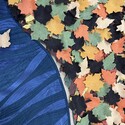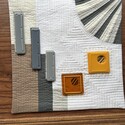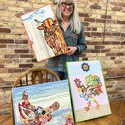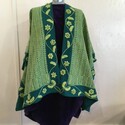Fabric art tells a story
April 28, 2023
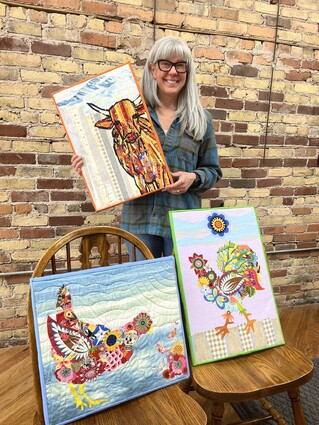
Cloquet area farmer Julianne Motis shows off her unique quilted animal artworks, which are part of the new fabric art show opening Friday at The Knot Gallery inside the Pine Knot News office.
The latest Knot Gallery art show features seven artists, who sew, knit, weave and otherwise create art out of fiber and fabric. Last week we featured three of the artists - this week we introduce readers to the other four.
Julianne Motis
Cloquet area farmer Julianne Motis is exhibiting three quilted pieces depicting a couple of incredibly colorful chickens and a cow, each one pieced together with fabric pieces of all shapes and sizes that come together to portray the animal, the same way a painting would use bold brush strokes.
Quilting is the quintessential American art form, with a long history, reflects Motis.
"Every quilt tells such an amazing story. I would love to do bigger things: It doesn't feel like work to me. And you never stop learning, and there's inspiration to be found everywhere. I like quilting with other people, too."
A Minnesota native who moved to Cloquet from Alaska after 13 years there, Motis appreciates the work of many Alaskans, including Native artists and quilters. She learned fabric artistry from her mother, an accomplished seamstress who also did upholstery.
Motis began making quilts from squares from her mom's upholstery books. "The 1970s fabrics were really colorful. I loved that first quilt."
Over the years, she has continued to quilt, including a complicated watercolor quilt for her daughter-in-law. She works on a 1969 Singer sewing machine. "I could sew two tires together, or make boat canvases," she said of the sturdy machine.
A big challenge for Motis is carving out the time to do it.
"You can spend all day sewing," she said. "But we farm, so each day I have a laundry list of things to do."
Sharon Wichman
Sharon Wichman is most interested in low-tech ancient methods of working with fibers. She started with nalbinding, a Norwegian form of needle binding dating back to the Middle Ages. In essence, it involves creating cloth with a needle, wrapping yarn around the thumb. The technique requires about the same amount of time as knitting.
Next she took a "sprang" class from Carol James, offered through the Duluth Fiber Guild in 2020. Sprang is a form of braiding on stretched threads: unlike weaving, there is no weft thread, and the warp threads can be linked in a variety of ways.
"Nalbinding was my gateway fiber art," Wichman said. "We have surviving examples of nalbinding and sprang from thousands of years ago, from all around the world. Nalbinding is a very slow technique, but sprang requires about the same amount of time as knitting."
More recently, she bought a spinning wheel and a loom, and has been working in backstrap weaving.
"It's not really weaving," she explains. "It's braiding. There is no weft, only warp threads - teeny tiny threads."
Wichman and fellow fiber artists have been selling their work at historical recreation events in Minnesota and Wisconsin. Although she is willing to sell if people are willing to pay the price, she also enjoys other people just enjoying the work.
Wichman is exhibiting two scarves, a bag, a belt, and three labyrinths with the same pattern done with different techniques.
Jane Willie
Jane Willie said her grandmother's quilting frame took up the entire living room. Quilting became a passion for Willie too, starting in the 1970s and picking up speed after the children left home.
Willie's quilts in our exhibit all were created by starting with a pattern, but then took on distinctive personalities of their own.
One is a purple "mystery quilt," created from her Halloween fabric stash at a rate of one block per month, then assembled in the final month. The second is a pickle dish pattern and was one of the first full-size quilts she made. The blocks are traditionally cut and pieced, as opposed to paper pieced.
"Scrappy quilts are my favorite, and with this one, I was able to pull in dozens, if not hundreds of different fabrics," Willie said.
The third quilt Willie developed from a pattern called Drunkards Wave and came out of a retreat in Montana a number of years ago, instructed by the pattern designer Judy Niemeyer. Again, she expanded on the pattern to make it her own.
Her fellow quilters are also part of the joy.
"I've met wonderful people, who are more than happy to share knowledge, ideas, friendship, and the exact shade of blue you may need from their personal fabric stash," she said.
Tah'tini Ho'okan
Tah'tini Ho'okan has been knitting for 20 minutes a day for 50 years.
She started knitting in grade school, after watching a girl knit in class and talking her mother into buying her some yarn. Other girls in the class showed her how.
Ho'okan's interest in knitting took her to the next step, after seeing women spin their own yarn.
"I come from a long line of crafty people," said Ho'okan, of Moose Lake. "I remember an old Scottish woman with a lace shawl and knitting a spider web with a knitting wheel.
Eventually she got her own spinning wheel with a drop spindle, an art she now has demonstrated more than once at the Carlton County fair.
A loom came next. She'd never woven on a real loom before, but took to it like a duck to water. The year before Covid hit, she exhibited at the Shepherd's Harvest Festival on a modest- sized, 3-foot by 5-foot floor loom with treadles. "I took off my shoes," she said. "It requires tactile skill. And away I go."
But the loom wasn't large enough for what she wanted to do. Next, she invested in a more versatile (and expensive) 63-inch loom, which allows her to make a wider range of projects, including rugs, fine cloth and more. Ho'okan explains that the time-consuming work of the loom is winding the warp and threading the tension right.
"It takes two hours to weave, but eight to 10 hours to get it all on and off the loom," she said.
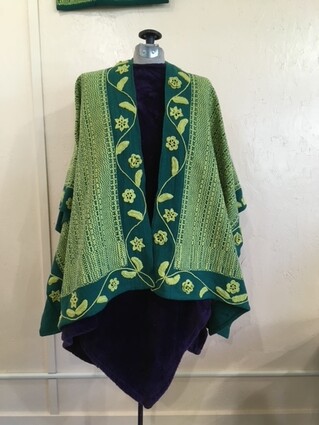
Tah'tini Ho'okan has been knitting and spinning yarn for five decades. She says her end creations often take less time than the set-up of the loom.
Ho'okan entered a towel weaving contest sponsored by The Woolery, and won the grand prize: a 1-pound cone of each of the 26 colors the fiber arts supplier creates.
The fiber artist will be demonstrating her loom work during the artist reception 5-7 p.m. Friday, April 28 at the Pine Knot News office at 122 Avenue C in Cloquet.
__________________________________
Art reception
The Knot Gallery will hold a fabric arts reception from 5 to 7 p.m. today (Friday, April 28) at the Pine Knot News office, 122 Avenue C, Cloquet. Come for the art, including a weaving demonstration by Tah’tini Ho’okan, and refreshments. Free.


